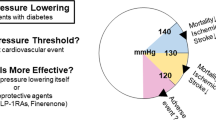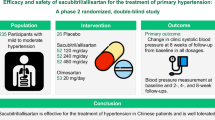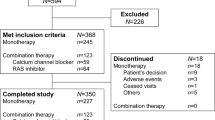Abstract
Type II diabetes and the dysmetabolic syndrome are becoming more and more prevalent, not only in the Western world, but also in many developing countries. The key issue is early prevention and treatment, not only antihyperglycaemic and antihyperlipidaemic treatment, but also, and maybe in particular, antihypertensive treatment. The first issue is first of all screening patients for elevated blood pressure and for microalbuminuria, especially if blood pressure elevation or diabetes is present. Especially, diabetic patients are at risk. The key feature in the therapeutic approach is blocking the renin–angiotensin system, which has proven effective in many original studies. Also the combination with diuretics is a key issue, since these patients have sodium retention. It has been discussed whether ACEi, ARBs or diuretics should be initial treatment, but usually a combination treatment is recommended to reduce blood pressure early and efficiently. The PREMIER study emphasized combination therapy, since the study had very efficient outcomes with combination therapy compared to an ACEi alone as far as blood pressure lowering is concerned, but also with reduction in microalbuminuria and, indeed, end point-reduction. Cardiovascular events showed a decreased incidence with the combination therapy with Preterax (perindopril/indapamide) compared with the enalapril group.
This is a preview of subscription content, access via your institution
Access options
Subscribe to this journal
Receive 12 digital issues and online access to articles
$119.00 per year
only $9.92 per issue
Buy this article
- Purchase on Springer Link
- Instant access to full article PDF
Prices may be subject to local taxes which are calculated during checkout


Similar content being viewed by others
References
Chen J et al. The metabolic syndrome and chronic kidney disease in US adults. Ann Intern Med 2004; 140: 167–174.
Mogensen CE . Microalbuminuria and hypertension with focus on type 1 and type 2 diabetes. J Int Med 2003; 254: 45–66.
Guidelines Committee. 2003 European Society of Hypertension–European Society of Cardiology guidelines for the management of arterial hypertension. J Hypertens 2003; 21: 1011–1053.
Chobanian AV et al. The Seventh Report of the Joint National Committee on Prevention, Detection, Evaluation, and Treatment of High Blood Pressure. The JNC 7 Report. JAMA 2003; 289: 2560–2572.
Kaplan NM . Nouvelles recommandations américaines: analyse critique. Am J Cardiovasc Drugs 2004; 4(Suppl 1): 7–11.
Vasan RS et al. Impact of high-normal blood pressure on the risk of cardiovascular disease. N Engl J Med 2001; 345: 1291–1297.
Mogensen CE et al. Effect of low-dose perindopril/indapamide on albuminuria in diabetes: Preterax in albuminuria regression: PREMIER. Hypertension 2003; 41: 1063–1071.
Opie LH, Schall R . Old antihypertensives and new diabetes. J Hypertens 2004; 22: 1453–1458.
Gress TW et al. Hypertension and antihypertensive therapy as risk factors for type 2 diabetes mellitus. N Engl J Med 2000; 342: 905–912.
Padwal R et al. Antihypertensive therapy and incidence of type 2 diabetes in an elderly cohort. Diabetes Care 2004; 27: 2458–2463.
Punzi HA, Punzi CF . Antihypertensive and Lipid-Lowering Heart Attack Trial Study; Trinity Hypertension Research Institute. Metabolic issues in the Antihypertensive and Lipid-Lowering Heart Attack Trial study. Curr Hypertens Rep 2004; 6: 106–110.
Lindholm LH et al. Metabolic outcome during 1 year in newly detected hypertensives: results of the antihypertensive treatment and lipid profile in a North of Sweden efficacy evaluation (ALPINE) study. J Hypertens 2003; 21: 1563–1574.
Julius S et al. Outcomes in hypertensive patients at high cardiovascular risk treated with regimens based on valsartan or amlodipine: the VALUE randomised trial. Lancet 2004; 363: 2022–2031.
Barnett AH et al. Angiotensin-receptor blockade versus converting-enzyme inhibition in type 2 diabetes and nephropathy. N Engl J Med 2004; 351: 1952–1961.
Lacourcière Y et al. Long-term comparison of losartan and enalapril on kidney function in hypertensive Type 2 diabetics with early nephropathy. Kidney Int 2000; 58: 762–769.
Muirhead N et al. The effects of valsartan and captopril on reducing microalbuminuria in patients with type 2 diabetes mellitus: a placebo-controlled trial. Curr Therapeutic Res 1999; 60: 650–660.
Mogensen CE et al. Randomised controlled trial of dual blockade of renin–angiotensin system in patients with hypertension, microalbuminuria, and non-insulin dependent diabetes: the candesartan and lisinopril microalbuminuria (CALM) study. BMJ 2000; 321: 1440–1444.
Brenner BM et al. Effects of losartan on renal and cardiovascular outcomes in patients with type 2 diabetes and nephropathy. N Engl J Med 2001; 345: 861–869.
Lewis EJ et al. Renoprotective effect of the angiotensin-receptor antagonist irbesartan in patients with nephropathy due to type 2 diabetes. N Engl J Med 2001; 345: 851–860.
Ravid M et al. Use of enalapril to attenuate decline in renal function in normotensive, normoalbuminuria patients with type 2 diabetes mellitus. A randomized, controlled trial. Ann Intern Med 1998; 128: 982–988.
Kvetny J, Gregersen G, Pedersen RS . Randomized placebo-controlled trial of perindopril in normotensive, normoalbuminuric patients with type 1 diabetes mellitus. Q J Med 2001; 94: 89–94.
Ruggenenti P et al. Preventing microalbuminuria in type 2 diabetes. N Engl J Med 2004; 351: 1941–1951.
Adler AI et al. Development and progression of nephropathy in type 2 diabetes: the United Kingdom Prospective Diabetes Study. Kidney Int 2003; 63: 225–232.
Gæde P et al. Remission to normoalbuminuria during multifactorial treatment preserves kidney function in patients with type 2 diabetes and microalbuminuria. Nephrol Dial Transplant 2004; 19: 2784–2788.
Gæde P et al. Multifactorial intervention and cardiovascular disease in patients with type 2 diabetes. N Engl J Med 2003; 348: 383–393.
Schernthaner G et al. GUIDE Study: double-blind comparison of once-daily gliclazide MR and glimepiride in type 2 diabetic patients. Eur J Clin Invest 2004; 34: 535–542.
Mogensen CE . Genetics and diabetic renal disease: still a big black hole. Diabetes Care 2003; 26: 1631–1632.
Strippoli GFM et al. Effects of angiotensin converting enzyme inhibitors and angiotensin II receptor antagonists on mortality and renal outcomes in diabetic nephropathy: systematic review. BMJ 2004; 329: 1–12.
So WY et al. Effect of angiotensin-converting enzyme inhibition on survival in 3773 Chinese type 2 diabetic patients. Hypertension 2004; 44: 294–299.
ACE-Inhibitors in Diabetic Nephropathy Trialist Group. Should all patients with type 1 diabetes mellitus and microalbuminuria receive angiotensin-converting-enzyme inhibitors? A meta-analysis of individual patient data. Ann Intern Med 2001; 134: 370–379.
Nakao N et al. Combination treatment of angiotensin-II receptor blocker and angiotensin-converting enzyme inhibitor in non-diabetic renal disease (COOPERATE): a randomised controlled trial. Lancet 2003; 361: 117–124.
Strippoli GFM, Jonathan CC . Combined treatment with angiotensin-converting enzyme inhibitors and angiotensin-receptor blockers to prevent end-stage kidney disease in patients who do not have diabetes. Med J Aust 2004; 181: 450–451.
Burnier M, Brunner HR . Angiotensin II receptor antagonists. Lancet 2002; 355: 637–645.
Marre M et al. Equivalence of indapamide SR and enalapril on microalbuminuria reduction in hypertensive patients with type 2 diabtes: The NESTOR study. J Hypertens 2004; 22: 1613–1622.
Author information
Authors and Affiliations
Corresponding author
Rights and permissions
About this article
Cite this article
Mogensen, C. New concepts in blood pressure-lowering management in diabetic patients: the case for early ACE inhibitor combination therapy with diuretics. J Hum Hypertens 19 (Suppl 1), S15–S20 (2005). https://doi.org/10.1038/sj.jhh.1001888
Published:
Issue Date:
DOI: https://doi.org/10.1038/sj.jhh.1001888
Keywords
This article is cited by
-
The incidence of potential drug–drug interactions in elderly patients with arterial hypertension
Pharmacy World & Science (2010)
-
Towards improving the clinical assessment and management of human hypertension: an overview from this Journal
Journal of Human Hypertension (2006)



